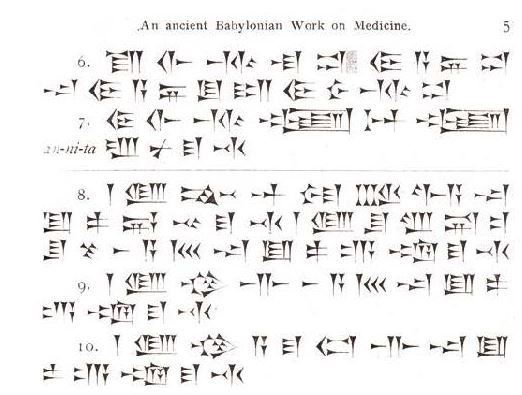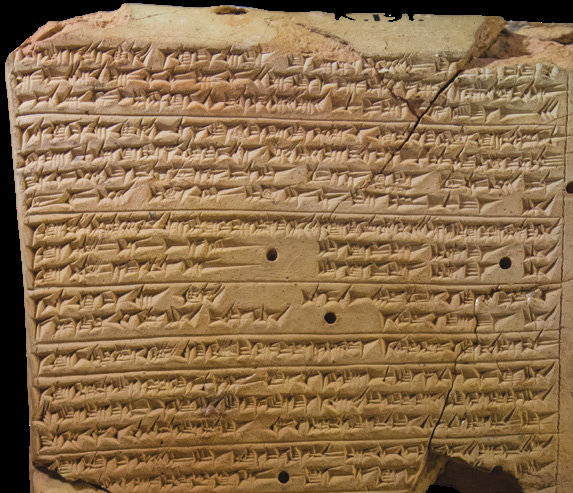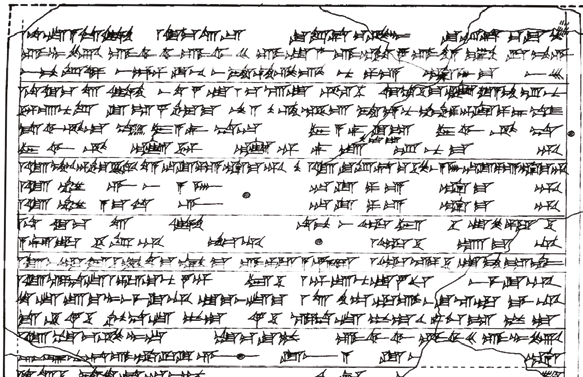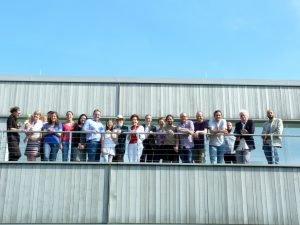BabMed Youtube Channel is open now, featuring the BabMed Imagefilm and a short video on the Medical Commentaries conference held in September 2017 at MPIWG Berlin.

Mark Geller, Jewish Chronicle Professor of Jewish Studies,
University College London, March 28, 2022
British Museum Department of Middle East Newsletter
The great Assyriological medical project that we have entitled NinMed has been running within the Department of the Middle East of the British Museum since 2020. Such international collaboration is not set up overnight, and here we sketch its origins and early development. The story began at Berlin with the Grossmeister of ancient Babylonian medicine, Franz Köcher. Herr Köcher was Professor for the History of Medicine at the Freie Universität Berlin, but he had almost no students and no colleagues who dared work with him, because of his intimidating reputation. He, it was generally accepted, knew everything there was to know about Babylonian medicine, for he had devoted his entire life to it (after five years as a tank commander in the Second World War). His office in his Berlin apartment in the Windscheidstrasse was effectively a university study room, complete with floor-to-ceiling card files recording every single word on every single Akkadian medical tablet. He also had stacks of transliterations and word-studies of Babylonian medicine, none of which came to be published. The Professor was too busy making hand copies (in six impressive tomes) of all cuneiform medical tablets from the Pergamon Museum in Berlin and the British Museum, the two largest and most important collections in the world. And there was one more side to him which everyone then knew of but never talked about: in the last days before the Berlin Wall was constructed, Herr Köcher packed his suitcases with all his research papers on Mesopotamian medicine and crossed over from East to West Berlin. He never returned, even after the Wall came down.
Tere were two younger colleagues from London with whom he had regular contact, which was very exceptional. One was Irving Finkel, and the other was Mark Geller from UCL. Neither would ever consider visiting Berlin without visiting Herr Köcher and his wife in the Windscheidstrasse. Finkel had a particularly close and productive relationship with Herr Köcher over many years, since he regularly sent him transliterations of unpublished Babylonian medical tablets from the British Museum. Geller did the same, but Herr Köcher used to hint that Finkel’s transliterations were more accurate. The only student who was actually brave enough to study with Herr Köcher came to London in 1984, to the Rencontre Assyriologique Internationale organised by Christopher Walker, then of the British Museum. She faithfully reported that Köcher had told her before departing, ‘regards to Finkel and Geller, but no one else!’
The problem with this situation was that everyone knew that, in the well-worn phrase, ‘Köcher is working on medicine’, and no one dared rival his dominance of the field. Two things changed the status quo. One was Köcher’s untimely death, aged 85. The second was Geller’s appointment as Guest Professorship at the Freie Universität Berlin, on secondment from UCL, from 2010–2018, under the auspices of a major 10-year research cluster, Topoi, funded by the Deutsche Forschungs-gemeinschaft, which employed some 200 researchers on all aspects of antiquity. Geller’s main programme in Berlin was to carry on Köcher’s research by launching the task of publishing editions and translations of Assyrian and Babylonian medicine, which was greatly facilitated by a five-year grant from the European Research Council for the project known as BabMed.



With an excellent BabMed team assembled, including Strahil Panayotov and later Krisztian Simko, something very unexpected happened. Before he passed away, Franz Köcher had sent to Finkel and Geller an invaluable reconstruction of a group of related tablet fragments from Yale, which turned out to be a unique catalogue of approximately 90 medical treatises from about 700 BC, from the city of Ashur. One additional fragment of the work from the Oriental Institute in Chicago had previously been copied by Finkel in the 1970s. This carefully structured catalogue with composition titles and line totals revealed that Mesopotamia possessed a highly systematic and extensive corpus of medicine more than two centuries before Hippocrates, often considered to be the father of modern medicine. The BabMed team began working on this catalogue, and eventually Strahil Panayotov realised that there was a parallel relationship between the Ashur catalogue of all the titles and the existing Assyrian medical tablets in Ashurbanipal’s Royal Library in Nineveh. Instead of being a large but random collection, as it had seemed, the Nineveh medical tablets could now be shown to constitute a medical encyclopaedia, organised into the same 12 major genres of medical literature set out in the Ashur medical catalogue. This discovery meant that, after the Berlin BabMed project concluded, the crucial next task was to reconstruct the medical library of Nineveh against the background of the ancient catalogue.
The problem was to find funding to assemble a new research team with sufficient knowledge and experience of working with Akkadian medical texts. Even experienced Assyriologists experience difficulty in reading cuneiform medical texts, due to the technical nature of the language and writing style. Fortunately, the years of work on medicine in Berlin provided the expertise which was needed, in Panayotov and Simko. The obvious choice for funding was to turn to the Wellcome Trust, which announced grant programmes for major research projects in Medical Humanities. The Trust has inspiring grant programmes which are well organised, with Wellcome staff even offering useful advice to applicants on how to create a successful application. The advisors warned, however, that final decisions on grant applications were made by special panels, and these panels changed regularly and were not always interested in all the topics submitted. They also gave sound advice: to make the application for Nineveh medicine more general than a simply textual project, but to show how important the material was for other fields, such as the history of medicine and various aspects of anthropology. The application was sent to two senior researchers at UCL who worked in other fields of medical history and who themselves had won Wellcome awards. Both were enthusiastic about the value of the project, and their further suggestions were incorporated into our submission.
After our initial submission was turned down, and a brief telephone call to Jon Taylor and Irving Finkel, it was decided that a new proposal could be submitted directly from the British Museum to the Wellcome Trust, to make this valuable treasure trove of medical history accessible and available, through digital editions and translations of Nineveh medicine. That proved successful.
During the first six months of the NinMed project, substantial textual material has been gathered, edited, and worked through, with the aim of providing accurate readings and translations of each text. Weekly online meetings of the entire team (the two researchers Panayotov and Simko, plus Taylor, Finkel and Geller) greatly facilitate the results. Two colleagues from Paris, two more from Berlin, and one from Geneva, also join this weekly working group, which reads through each text line-by-line with problematic passages analysed and discussed. The idea is to create translations which are not only meant for specialists but will also be meaningful to medical historians and members of the public, especially doctors who have an interest in ancient or Middle Eastern medicine. The aim is to have all major texts in the Nineveh medical library transliterated and translated by the end of the project.
Postscript: the progress of scholarship after 171 years (1850–2021)
In describing our great new Project on the cuneiform medical texts of the Nineveh library, it is fitting to acknowledge which of the many such tablets in the British Museum was the first to be discussed in print by one of the Assyriological pioneers of the 19th century. The answer proved to be the large Nineveh tablet numbered K 191+, a study and translation of which was given as early as 1850 by the Oxford Assyriologist and polymath A.H. Sayce (1846–1933), who published his article entitled ‘An ancient Babylonian Work on Medicine I’ in the journal Zeitschrift fur Keilschriftforschung II/1: 1–14. Curiously, it is exactly this tablet, part of the ancient medical therapeutic series entitled ‘If a man suffers from a cough’, that the international team were jointly reading under the editorship of Dr. Krisztian Simko when this Newsletter report was prepared. It is only fitting to state that everyone was astonished when they saw what Sayce had been able to accomplish at so early a stage of Assyriological work, for he had achieved an extraordinary level of understanding of this ancient technical literature with no published work by other scholars to depend on, although it is probable that T.G. Pinches, then in the department, might have helped. In tribute to our early predecessor, we illustrate Sayce’s treatment printed in a cuneiform font, a hand copy of the same text and a modern digital photograph for comparison.
The Middle East Department of the British Museum has just received a Wellcome Research Resources Award in Humanities and Social Science.
The Project, ‘Introducing Assyrian Medicine: Healthcare Fit for a King’, plans to make the corpus of medical texts from Nineveh in the British Museum accessible online.
The Wellcome award will be for up to £353,277.00 over 36 months, administered by the British Museum.
The proposed start date is 04 May 2020. The PI of the project is Jonathan Taylor, with collaborators Irving Finkel from the British Museum and Mark Geller from University College London.
The two project curators working on the Project will be Strahil Panayotov and Krisztian Simko, both of whom previously worked in the ERC Project BabMed at the Freie Universität, Berlin.
First posted by Mark Geller <m.geller@ucl.ac.uk> via AGADE list April 24, 2020.
Markham J. Geller and Strahil V. Panayotov
The Nineveh Treatise
Band 10 in Die babylonisch-assyrische Medizin in Texten und Untersuchungen
Funded by: European Research Council (ERC)
De Gruyter | 2020
https://www.degruyter.com/view/title/528335 [Downloadable, likely by chapters, after June 15] ==========================
OVERVIEW
There is to date no comprehensive treatment of eye disease texts from ancient Mesopotamia, and no English translation of this material is available. This volume is the first complete edition and commentary on Mesopotamian medicine from Nineveh dealing with diseases of the eye.
This ancient work, languishing in British Museum archives since the 19th century, is preserved on several large cuneiform manuscripts from the royal library of Ashurbanipal, from the 7th century BC. The longest surviving ancient work on diseased eyes, the text predates by several centuries corresponding Hippocratic treatises. The Nineveh series represents a systematic array of eye symptoms and therapies, also showing commonalities with Egyptian and Greco-Roman medicine.
Since scholars of Near Eastern civilizations and ancient and general historians of medicine will need to be familiar with this material, the volume makes this aspect of Babylonian medicine fully accessible to both specialists and non-specialists, with all texts being fully translated into English.
Doctor Honoris Causa of Sofia University St. Kliment Ohridski
At a ceremony in Aulata, Professor Mark Geller was honored with the
honorary title of Doctor Honoris Causa by the Sofia University “St.
Kliment Ohridski “. The proposal for awarding the honorary title of
the oldest Bulgarian higher school is to the Faculty of Slavic
Philology and the Faculty of History.
Prof. Mark Geller is one of the recognized leading experts in the
field of Assyriology and ancient Hebrew Studies, whose contributions
to the fields of ancient linguistics, ancient medicine and ancient
magic and spells have established a standard in contemporary
research.” [….]
See pictures and a video recoring of the ceremony at this link.
contact: Slavka Karakusheva, Sofia University St. Kliment Ohridski
International Relations Office | 15, Tsar Osvoboditel, 1504, Sofia, Bulgaria
T: (+359) 2 9308422 | @: skarakusheva@admin.uni-sofia.bg
BabMed PI Mark Geller and deputy head J. Cale Johnson would like to announce that transliterations of the first six volumes of Franz Köcher’s Babylonisch-Assyrische Medizin (BAM) are now available online at CDLI:
Please send any comments, corrections or suggestions to the following email address:
Preliminary versions of many of these transliterations as well as information on parallel passages are also available at the BabMed Project website:
https://www.geschkult.fu-berlin.de/e/babmed/Corpora/index.html
Over the last five years or so, members of the BabMed Project as well as a number of other contributors and friends of the Project have provided transliterations, advice and corrections. We would like to express our sincere thanks for their efforts and contributions. They are listed below:
BabMed Staff
Ulrike Steinert
Strahil V. Panayotov
Eric Schmidtchen
Krisztián Simkó
Marius Hoppe
Marie Lorenz
John Schlesinger
Till Kappus
Agnes Kloocke
Contributors
Annie Attia
Gilles Buisson
Sona Eypper
Marten Stol
Frans Wiggermann
Henry Stadhouders
Nils P. Heeßel
Martin Worthington
Franziska Desch
Marvin Schreiber
Tomoki Kitazumi
Johannes Bach
Kaira Boddy
Lidewij van de Peut
Visualizing the invisible with the human body: Physiognomy and ekphrasis in the ancient world Edited by J. Cale Johnson and Alessandro Stavru
De Gruyter (Science, Technology, and Medicine in Ancient Cultures 10)
Hardcover ISBN 978-3-11-061826-6 RRP € [D] 99.95 / US$ 114.99 / GBP 91.00*
OPEN ACCESS (through funding from the BabMed Project)
Available online at:<https://www.degruyter.com/viewbooktoc/product/509865>
Part I: Mesopotamia and India
1. Demarcating ekphrasis in Mesopotamia — J. Cale Johnson (pp. 11-40)
2. Mesopotamian and Indian physiognomy — Kenneth Zysk (pp. 41-60)
3. Umṣatu in omen and medical texts: An overview — Silvia Salin (pp. 61-80)
4. The series Šumma Ea liballiṭka revisited — Eric Schmidtchen (pp. 81-118)
5. Late Babylonian astrological physiognomy — Marvin Schreiber (pp. 119-140)
Part II: Classical Antiquity
6. Pathos, physiognomy and ekphrasis from Aristotle to the Second Sophistic — Alessandro Stavru (pp. 143-160)
7. Iconism and characterism of Polybius Rhetor, Trypho and Publius Rutilius Lupus Rhetor — Dorella Cianci (pp. 161-182)
8. Physiognomic roots in the rhetoric of Cicero and Quintilian: The application and transformation of traditional physiognomics — Laetitia Marcucci (pp. 183-202)
9. Good emperors, bad emperors: The function of physiognomic representation in Suetonius’ De vita Caesarum and common sense physiognomics — Gian Franco Chiai (pp. 203-226)
10. Physiognomy, ekphrasis, and the ‘ethnographicising’ register in the second sophistic — Antti Lampinen (pp. 227-270)
11. Representing the insane — Maria Gerolemou (pp. 271-282)
Part III: Semitic traditions
12. The question of ekphrasis in ancient Levantine narrative — Cory Crawford (pp. 285-320)
13. Physiognomy as a secret for the king. The chapter on physiognomy in the pseudo-Aristotelian “Secret of Secrets” — Regula Forster (pp.
321-346)
14. Ekphrasis of a manuscript (MS London, British Library, Or. 12070).
Is the “London Physiognomy” a fake or a “semi-fake,” and is it a witness to the Secret of Secrets (Sirr al-Asrār) or to one of its sources? — Emily Cottrell (pp. 347-442)
15. A lost Greek text on physiognomy by Archelaos of Alexandria in Arabic translation transmitted by Ibn Abī Ṭālib al-Dimashqī: An edition and translation of the fragments with glossaries of the Greek, Syriac, and Arabic traditions — Johannes Thomann (pp. 443-484)
The end? Far from it…
Over the past five years, the BabMed team and our project associates have worked hard to break the proverbial lock on Cuneiform and Talmudic medicine. It was the ERC 7th framework and the great support by Freie Universität Berlin, especially the Department of History and Cultural Studies, that enabled us to systematically study Ancient Babylonian Medicine for the first time since the BAM volumes of Franz Köcher and create a fresh awareness for these early scientific achievements within the academic community as well as the general public.
Our BabMed Annual Workshops and the BabMed Corpora Online edition have, in combination with the BabMed volumes with de Gruyter, Mohr Siebeck and Routledge publishers, prepared the grounds for future research on the History of Medicine not only in Assyriology and Talmudic Studies, but al so in Classical and Ancient Studies and Egyptology.
so in Classical and Ancient Studies and Egyptology.
With sincere thanks to everyone involved in the successful course of the BabMed project, and: there is still a great deal left to do.
The BabMed team
J. Cale Johnson left the Freie Universität Berlin in July 2017, but has kept his post as Deputy Head of the BabMed Project. We are happy to announce that he has now taken up a post as Senior Lecturer in Assyriology at the University of Birmingham’s department of Classics, Ancient History and Archaeology (https://www.birmingham.ac.uk/schools/historycultures/departments/caha).
The Journal des Médecines Cunéiformes 31 is out and will be sent to subscribers.
You’ll find the contents of this new issue below.
Le Journal des Médecines Cunéiformes, 2018 – N° 31
Note des éditeurs
Les parties du corps dans la série šumma amêlu suâlam maruṣ
Danielle Sandra Cadelli
Words for Loss of Sensation and Paralysis in Assyro-Babylonian Medical Texts: Some Considerations
Silvia Salin
‘The Physician is the Judge!’- A Remarkable Divine Dialogue in the Incantation: ÉN ur-saĝ dasal-lú-ḫi igi-bé ḫé-pà saĝ-ḫul-ḫa-za ḫé-pà
Elyze Zomer
Mieux vaut être riche et bien-portant que pauvre et malade » : de BAM III-234 à Job
Annie Attia
The libbu our Second Brain? (part 1)
Annie Attia